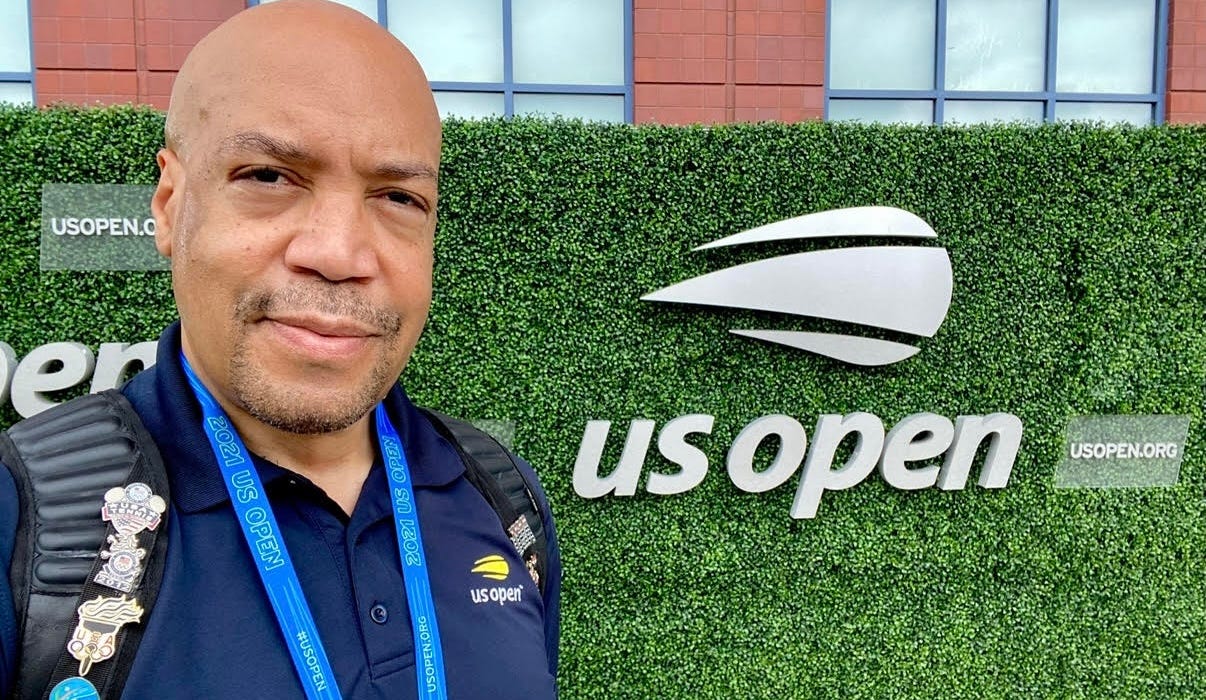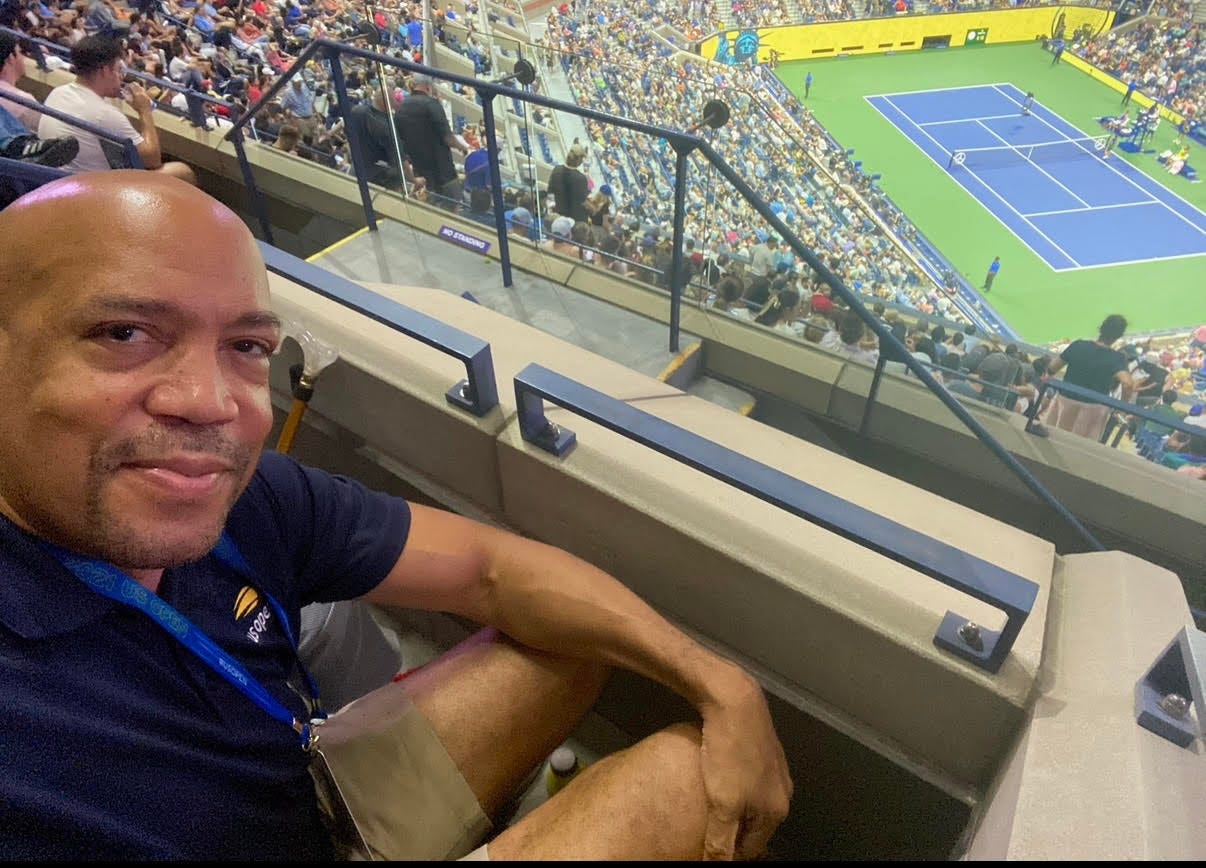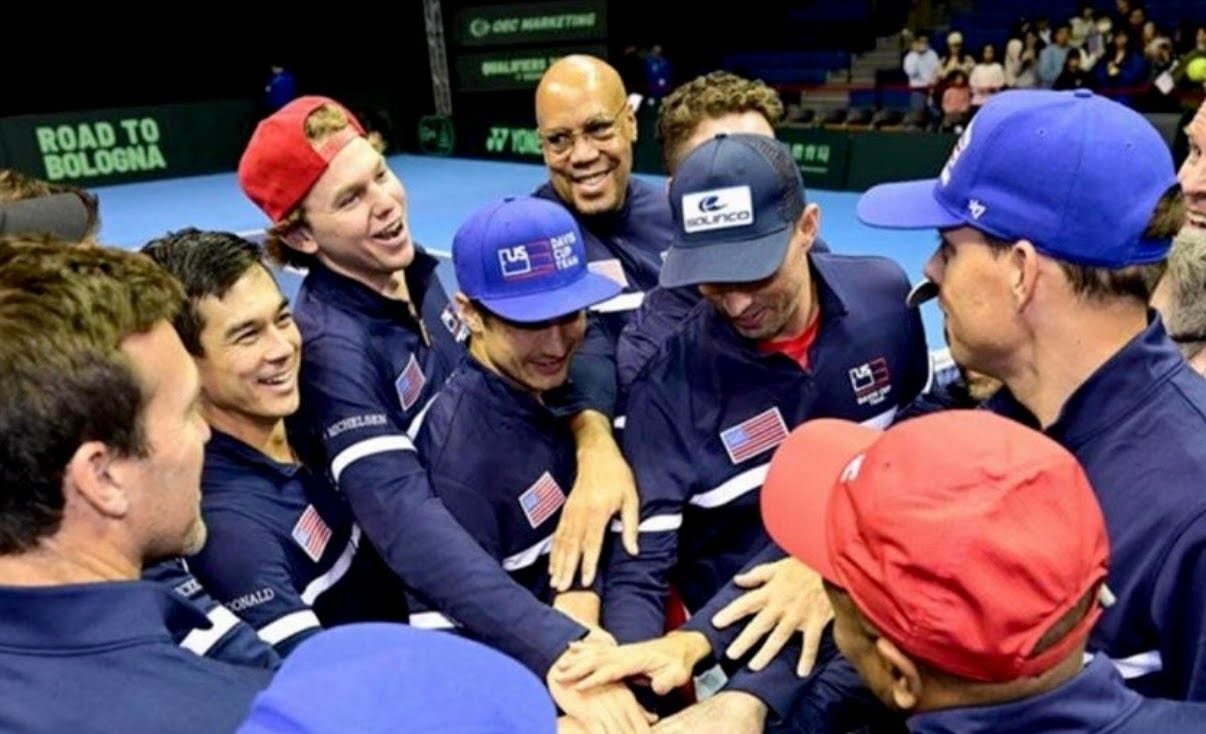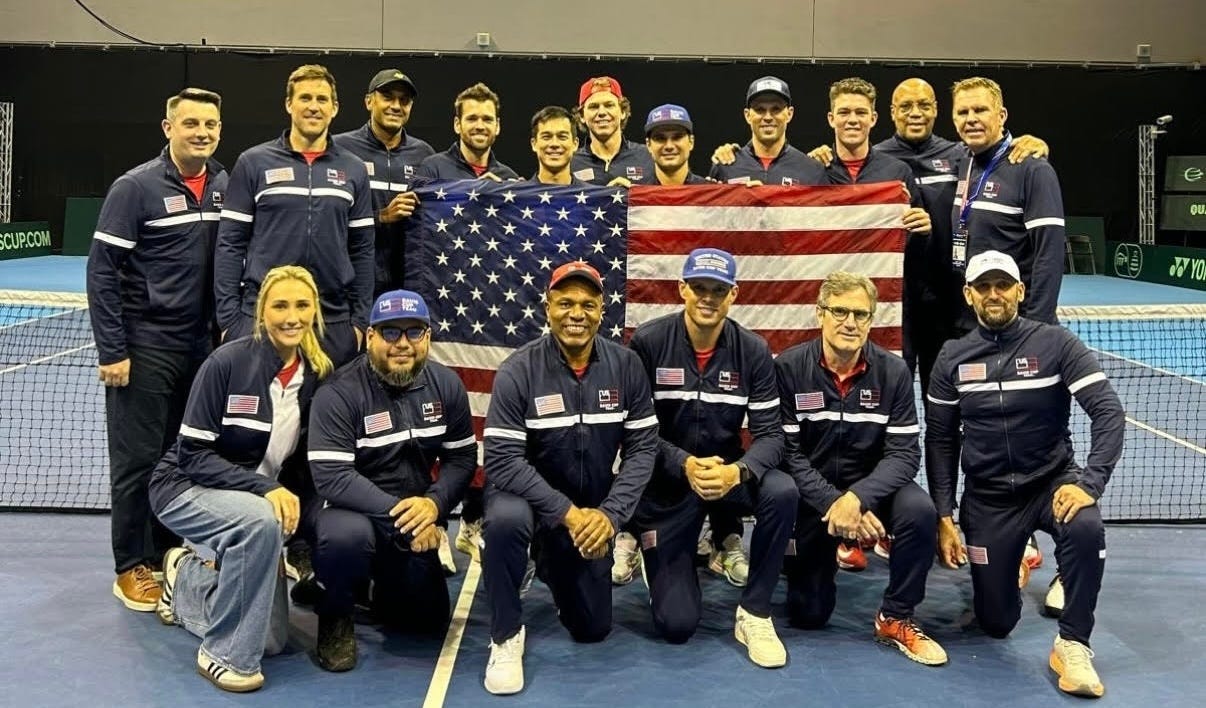What it's like to be a massage therapist for the US Open and Davis Cup
An interview with the GOAT Keith Murray, with thoughts from John Isner and Stevie Johnson.
There are so many interesting people working behind the scenes of tennis to help the sport run, so today I’m excited to introduce a new series called The Insider, where I’ll be interviewing folks doing really cool shit beyond the spotlight. My first ‘subject’ is extra meaningful.
The Insider
Keith Murray, massage therapist for the US Open and US Davis Cup team
Call it fate, kismet, or just a lucky Wednesday. I was lying on a massage table for the hundredth time in three years, hoping to melt away my various aches and pains, when I discovered that the person working on my body was also the go-to guy for American pro tennis players. I’d been seeing Keith Murray for a few months by that point and felt instantly comfortable with him; unlike many casual massage therapists I’d seen before, he had a truly comprehensive knowledge of the body, teaching me something new about myself during every session. He never looked at me with doubt or judgment as I explained the myriad, unusual ways my body had fallen apart, a rarity when you’re talking to practitioners about chronic pain. I described the sensations I was feeling with such specificity that he marveled at how “in tune” with my body I was, rather than trying to convince me that, actually, I was thinking about it too much.
As I’ve written before, tennis had become a salve for me as my body slipped into perpetual discomfort. So as Keith and I discussed our summer plans and he casually mentioned the US Open, I perked up—he was a tennis fan, too? I quickly learned he was much more than that, and tried my absolute worst to play it cool as he revealed the depths of his career.
Murray was one of the first massage therapists to work the US Open when it began offering massage services to players in 1995, and he’s been doing it ever since. In 2011, he became the sole massage therapist for the US Davis Cup team, the role he holds most dearly. He’s also had stints with the US Olympics tennis team in London (2012) and Rio de Janeiro (2016).
And there’s a reason he’s become so embedded in the sport—he’s not just great at what he does, but beloved.
When I first found out about his secret-to-me career, I asked Rajeev Ram if he knew Murray (which was really an attempt to ensure I wasn’t having my first delusion). “To say I know him is an understatement,” he joked in response.
Alongside Ram and the Bryan Brothers, Murray grew especially close to the top singles players of the 2010s, particularly the group we now refer to as the Nothing Major guys, who happened to mention him in the first episode of their popular podcast.
“We traveled the world together for years, and I got to work with them for the full arc of their careers,” explained Murray. “I mean, I met Stevie Johnson when he was still in college.”
Naturally, I had to find out if they also thought Murray was the GOAT.
“There is no better massage therapist than Keith Murray,” John Isner told me. “He knows the body inside and out and was always a vital piece of our Davis Cup team. Everyone would fight over who got to get on his table first because he is just that good.” Plus, he added, he’s easy to talk to and has great taste in music—what more could you want?
Stevie Johnson agreed. “Keith is the absolute best,” he said. “We were so lucky to have him with us. He knew our bodies so well, and whenever we were on the table, we knew we would get back to feeling our best the following day.”
I spoke to Murray about his unexpected road to tennis, what his job at both the US Open and the Davis Cup is really like, and how to be a sane tennis fan (a skill I don’t possess).
Ok, Keith, tell me, how did you get such a cool job?
I started working with tennis players at the US Open 30 years ago, in 1995. Back then, they didn't even have a team of massage therapists working for the tournament, so the head of the ATP at the time went to the Swedish Institute to recruit guys to work in the men's locker room at the tournament. The Institute, where I had graduated three years prior, selected five of us to interview with them, and the rest is history.
So the program has grown a lot since then, I’m sure.
The science behind physiotherapy and massage, and how these modalities benefit athletes, has come so far. I mean, there were literally six of us in the men’s area when we started in ‘95, and it's grown to 28 massage therapists this year for the men alone. It was so new to the tournament back then, and we were essentially creating the program as we went along. We started having guys line up for our services, so the tournament quickly realized how important it was for the athletes. Needless to say, the massage room is much bigger today.
But so many tennis players today bring their own entourage, including a massage therapist. Generally, the top four players work with their personal support team, while the players that use our services range in ranking from top 10 up, as well as the doubles and junior players.
Were you into tennis when you first started doing this job?
I've grown to love it more. I was more of a casual viewer at first, similar to people who just watch the playoffs of a sport— they wait the whole season just to watch the end. But no, I wouldn't say I was a fan fan. But now I have a vested interest, especially since the work that I did with the US Open led to me becoming a massage therapist for the American players and the Davis Cup team. I love the sport now, but early on, it was funny, because a tennis player asked me once, “Why did you pick tennis?” And I said, “I didn't pick tennis. Tennis picked me.”
That’s an iconic line. So what does a typical day look like for you when you’re working the US Open?
The US Open is run like a tight ship. We’re in a massage room that’s part of the locker room. There are about five tables, and about seven of us working at any given time, and we're just there waiting. A lot of the American players, because they know me, will just text me and ask to get in. Otherwise, we just have a board with time slots that players can sign up for—it’s pretty basic.
It’s a full day. We're shifted so that we work eight hours, and then the next crew comes in. But, depending on which shift we get, we're responsible until the last person comes off the court at night, regardless of what time it is. So at the US Open, that can be like one or two o’clock in the morning. Each of us only works a few days a week, so we get a break.
Do you get to watch any tennis?
When I'm inside, there are monitors everywhere, so we get to see that, but I do get to watch from the stands as well. Our credentials give us complete access and allow us to sit anywhere, which is great.
What are the most common problem areas that tennis players come to you to have worked on during the tournament?
The lower back easily takes the top spot, as well as the glutes and quads.
Interesting. I was expecting you to say the shoulder or something in the upper body.
That’s a problem area for sure, but in terms of the top four areas, it doesn't even make the list. There’s a lot of bending and a lot of lateral movement in tennis, so they really find that they feel it in their lower back and into their glutes and legs.
There’s been a lot of discussion about the uptick in injuries in recent years. What are your thoughts on that as someone who’s been on the frontlines with players for the last 30 years?
Yeah, there has definitely been an increase. I mean, if you were to watch tennis back in the '70s or '80s, it's almost like watching badminton. There’s just a much higher level of athleticism now. So, with more athleticism and pushing of the body, the possibility of an injury really increases. That’s the potential downside of the physicality of today’s tennis. But it also stems from the schedule they maintain—I mean, they're playing 11 months out of the year, so it's very grueling on the body.
On the other hand, there’s so much more physio and massage work being done; it's become such an important part of their aftercare and preparation in general, which has helped to stave off a lot of injuries that would’ve happened otherwise. I also think all of this work has helped prolong careers. We had Federer playing until 41, Djokovic is 38 and still going, and so on. They were done by 27 back in the day.
Yeah, we're seeing that with every sport now. There’s a 360-degree approach to taking care of your body; it’s a job that never stops.
Never stops! It was funny, because even Venus Williams said at a tournament the other day, something along the lines of, “This job is hard; when we're not playing, we're working to get ready to play.” They’re working hard every day, and it’s a big investment.
When you’re working on players before matches, do you talk to them or do they mostly zone out? Do you ever get a sense of their nerves?
With those that I know well, it’s just like two friends chatting, and we rarely talk about what they're about to do. The conversation often gets personal—I hear about their families, their kids, that kind of stuff. I never get a sense of their nerves, which is kind of crazy, knowing the level that they're competing at and the fact that they’re essentially about to put on a performance.
However, most of the work we do is after a match, so if they've lost, they’re not happy, and very obviously not happy. But surprisingly, they shake it off very quickly.
Most of them don't zone out, and it's one of those things where we kind of wish they would [for their own sake], but with people playing at this level, there's almost a constant need to do something. So a lot of times they’re texting, responding to emails, or doing whatever they need to for social media while they're getting a massage and talking to us.
What is something you’ve learned through this job that might surprise people about the pro players or the US Open?
People often think that the players, since it is a competition, are not enjoying each other's company in the locker room. So I think it might be surprising to some extent that the two guys who might be about to walk on court to compete are often just lying right next to each other on tables, chatting it up. It’s like a fraternity back there sometimes; there's a lot of camaraderie. I had a friend once ask me what it was like between Andre Agassi and Pete Sampras, and I was like, “Sometimes right before the match they’re just sitting there talking to each other before they go out.”
I do love that part of tennis. Obviously, there are big rivalries and some people who don't like each other, but it seems that for the most part, these players get along and care about each other.
It's true, and it's across international lines. Of course, the players from each country may bond differently, but they all see each other a lot.
The sport is so widespread. Even when I was traveling all over the world, people would ask me, “What's your favorite tournament?” And for me, it almost didn't matter, because I was just there to do what I was there to do. When you’re a fan, going to Wimbledon versus the Australian Open, it’s going to be a much different experience at each. But for me, I'm just looking for the room that I'm supposed to work in. And that's a little like how they experience it as players—sometimes they don't even know what country they're in.
I don't blame them with how often they travel, my circadian rhythm would be such a mess.
Yeah, they find a way, though. Youth helps.
I feel so connected to certain players as a fan, and I don't even know them. So I'm curious, have your personal relationships with players made their wins and losses more intense?
Not really. I feel it when I'm on the Davis Cup team, but I don't feel it as much at the Open. My relationship to the Davis Cup team is so much closer than just working a tournament. The players often feel a level of responsibility to the broader team. They’ll sometimes say to me, “Sorry, Keith, I'm sorry I didn't get the job done.” So I always find it interesting that they feel like they've disappointed others, especially in a team situation. You don't get that as much in an individual tournament. But the experience of them winning or losing, I don't feel the emotion of it. Of course I want them to win, but I don't feel emotionally involved in their losing.
Damn, I wish I could say the same. It sounds like you're very well adjusted.
[cracks up at my insanity] I’m not that emotionally invested in sports in general. I'm not the screamer at a baseball game, not the screamer at a basketball game. So I think that's more of a me thing than it is a widespread thing. Especially for the physios who work with a particular player, they're with them all the time, they’re essentially living their life, so they’re much more invested in their results. They live and breathe it; I don't.
Yeah, because they spend every day with each other, so it's kind of like a family, right?
Absolutely. And generally, those people are much more involved in the sport itself. You know, it's kind of a fluke that I'm here to some extent. I would say that 99% of the people who are working in the sport are very into the sport. I'm not. You know I like tennis, but if we all go out to dinner, I don’t feel like we have to talk about tennis. It’s funny because the Davis Cup team doctor and I always joke about that. We’re like, Can we have a little bit of a different conversation today?
It sounds like you have a healthy relationship to it—I should try that. Speaking of Davis Cup, how much are you traveling with them throughout the year, and what is that experience like?
It’s two to three times a year now. We’re about to go to Delray Beach in September for the second round qualifier against Czechia. We often get to the final, but we haven’t been winning the Davis Cup lately.
It’s a lot of fun, very familial. We do everything as a team. People often ask me if I get to see the cities we're in, and while I could, because I don't necessarily have to go with them when they're essentially practicing all day, I usually don’t. We all just stay together. We have breakfast together in a VIP room that the hotel sets up for us and then we go to the courts and the players practice. The team doctor and I essentially act as the ball boys unless our services are needed. Generally, we do most of that body work after dinner.
It feels very inclusive, which I’ve always really enjoyed. Of course, the players are the strength of the team—without them, it doesn't happen, right? But me, the doctor, the stringer, the physios, we’re considered such a part of the team that when the team is meeting mayors and dignitaries in different cities and countries, we’re all there too.
I hope you realize how cool this job is. I’m eternally jealous.
Oh yeah. It went to a whole other level when I got on the Davis Cup team because I got much closer to the players. I remember I was with the Bryan Brothers one day early on, just marveling at the fact that I was sitting in a car with them [laughs]. Before that, at the US Open, it was more like, you come in, do what you have to do, and then you leave. But now I was living with these guys, so I pinch myself a lot.
Thanks for reading! Let me know in the comments who you’d like to see featured next in The Insider. As always, if you have tennis news or tips to share, email jessica@hard-court.com.







Super interesting read!
There's all these roles behind the players that we just don’t hear about.
Such a cool job! 😭